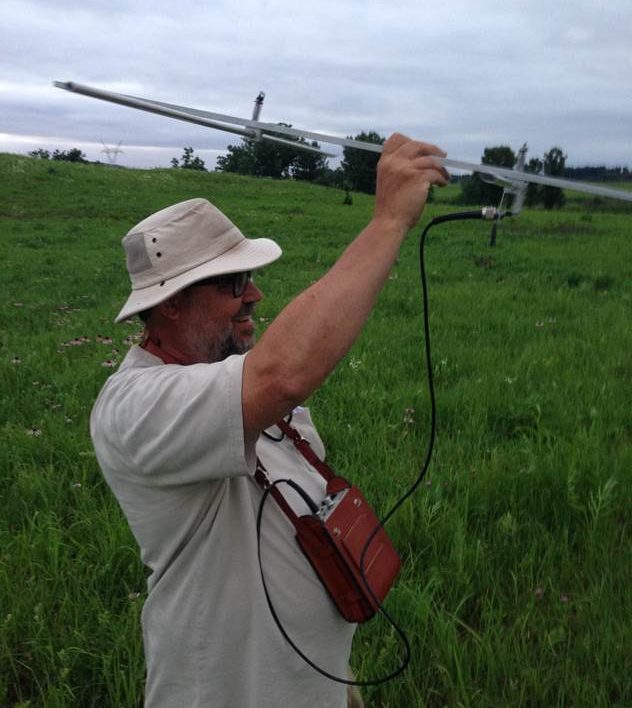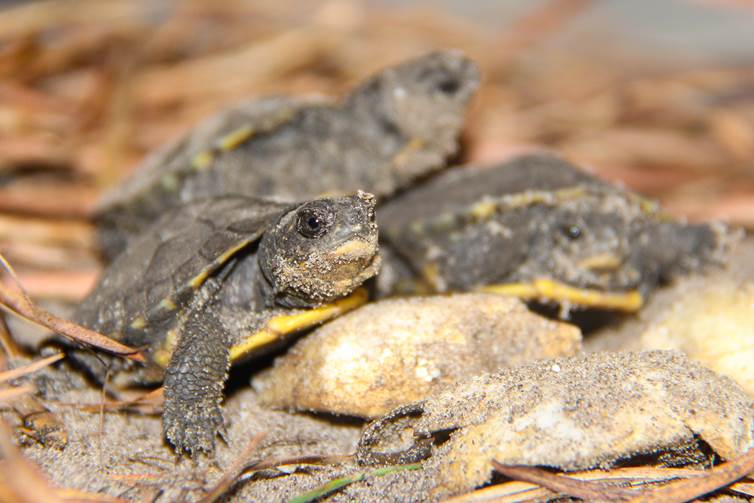What do you do if you only have eight known Blanding’s turtles in the population you’re studying at Illinois’s Nachusa Grasslands Preserve?
Well, if you’re Rich King and colleagues, you lure them into hoop traps baited with sardines, attach tiny transmitters to their shells with an epoxy resin, and then spend the months from April to October using radio telemetry to track them by hiking the prairie holding an antenna above your head, all of which is not as easy as it may sound.
Still, notes King, professor and chair of the Department of Biological Sciences of Northern Illinois University, “all of that effort can really pay off when it comes to learning more about the Blanding’s at Nachusa, and what we can do to help the population grow.”
The Same Eight Turtles Since 2013
Illinois is in the heart of the Blanding’s turtle’s historic range, but — like most species dependent on grassland habitats — populations of this small turtle with a bright yellow throat have dwindled with the prairie and its wetlands. At Nachusa, researchers have been studying the Blanding’s here since 2013 and became increasingly concerned when they kept finding the same eight individuals year over year.
“That’s a bad sign for the population,” says Bill Kleiman, Nachusa Grasslands project director. “When you find the same turtles repeatedly, it suggests the entire population is about eight individuals. And these eight were all older adult turtles. If you aren’t finding any young ones, it means that recruitment is low.”
When it comes to their lifecycle, Blanding’s turtles don’t have it easy. They spend most of their lives in wetlands, but females move away – sometimes far away – from the water to lay their eggs in sandy uplands with decent sun exposure. (They actually travel farther on average to nest than either painted or snapping turtles.)
And while the turtles in the wild are very long-lived, on average 50 to 70 years, they don’t reach sexual maturity until they’re about 15 years old. So finding young and maturing turtles within a population is important for determining the long-term viability of that population.

Which is Where Radio Telemetry Tracking Comes In
During the 2016 Blanding’s nesting season at Nachusa, King (with the help of other researchers and graduate students) tracked five females and one male. The study helps researchers determine where the turtles are moving and enables them to pinpoint which areas to focus on protecting. And while it may be a little counter-intuitive, it turns out that bison are actually important to creating habitat for Blanding’s.
Bison were reintroduced to Nachusa in 2014 and researchers are studying whether the turtles follow the herds. Because they are so large and heavy, bison can create new wet habitats when the places where they’ve wallowed fill with rainwater.
Radio telemetry was also important for giving researchers an opportunity to help find and protect nests.
“Rich King came out a lot,” says Kleiman, “to try to catch the females in their brief action of nesting and laying eggs. And was able to find and protect two nests with chicken wire tents to protect them from predation by raccoons and skunks digging up the eggs. Blanding’s nests are often destroyed within a day of laying so having two protected nests was great.”
TIL: Blanding’s turtles seem to like, well, sardines.
One protected nest produced eight hatchlings and one produced three, but even hatching successfully is only half the battle for a Blanding’s (as it is for most species). Once the young turtles are out of the shell, they still face a lengthy and hazardous trek to the shelter of the wetlands where they’ll spend most of their lives.
For King, knowing where the nests are means they can monitor their development and then “head start” the hatchlings by taking them to the wetlands and sparing them the overland journey.
“It’s a lot of work protecting nests and head starting the young turtles,” notes King, “but it’s worth it because now we know we have hatchlings in the wetlands.”
Monitoring the nests also gave King and his colleagues the chance to attach transmitters to the hatchlings. When King was tracking them at Nachusa last November, the turtles “looked to be in deep spots in the wetlands. [Blanding’s hibernate in the organic layer at the bottom of wetlands.]”
The Future of Blanding’s at Nachusa
“In Illinois,” notes King, “Blanding’s turtles are restricted to the northern part of the state. They have serious challenges here because of transportation infrastructure and habitat loss.”
Part of the goal of the work at Nachusa is to not only expand the population of Blanding’s turtles on the preserve and in the wider area, but also to understand how the turtles use the landscape so scientists and land owners can implement management plans that promote species increase and survival.
The 2017 field season at Nachusa still has a couple of months to run, but Rich King and his colleagues have been out there hard at work. Stay tuned for an update later this fall on how the 2016 hatchlings managed their first year and what this year’s radio telemetry tracking has shown scientists about the future of Blanding’s turtles at Nachusa.




This novel, and sensible cross species approach seems to me to be a brilliantly effective one!
THANK YOU FOR ALL THAT YOU HAVE DONE AND WILL CONTINUE TO IN THE FUTURE TO SAVE OUR EARTH.
Thanks for the article. Any update yet?
Thanks so much for asking. No update yet. The field season is just ending so I hope to hear something soon.
It is a travesty that only 1% of the original tall grass prairie exits. We destroyed it to grow corn, that is mostly used to feed livestock. We killed off the bison (30-40 million) to replace them with ( an estimate 40-45 million) cows. Why couldn’t we just leave things alone? Most people do not have a clue that the tall grass, mid and short grass prairies once had more animal diversity than our forests. Millions of bison, deer, antelope, bears, wolves, prairie dog, ferrets, badgers, porcupines, turtles, songbirds, burrowing owls, prairie chickens, grouse, and so many species too numerous to name. Unfortunately, two big things make restoring large tracts of prairie impossible – human overpopulation and our agriculture system that seeks to feed the world for huge profits. Large farmers make a fortune in subsidies and so do corporates – whose fertilizers and chemicals pollute the water and soil. Go down the Mississippi river to where it meets the Gulf and you will see the effects of all the chemicals and fertilizers used in agriculture today. In my opinion only small and mid -size farms that are organic should receive any subsidies. Large tracts of connecting prairies forests, wetlands etc. are needed to ensure the continuation and diversity of species. Let’s face it, we are just to greedy to make that happen.
thank you. great work what an excellent job you have,l really wish you weren’t needed.but thank you. this was a great and hopeful article.
It made smile .
Nice article. And thanks to Rich King and his team for assisting the survival of the Blanding’s turtles.
What a fabulous undetaking! I truly look forward to reading your update about the hatchlings.
It would be a wonderful thing if more Illinoisans were aware of the rarity of of the Blanding’s turtles. This article certainly helps, but it would be nice to see you get the Chicago Tribune to run a story about it. Just a suggestion. Keep up the excellent work.
I grew up in Madison, WI, during the 50s, and when I was about 10-12 years old I came face to face with a large Blanding’s turtle while tromping around in the cattails at the edge of Lake Mendota. He looked up at me and seemed as surprised as I was. Not knowing any better I took him/her home for a few days to check him out, then released him back into the cattails. That was the only Blanding’s turtle I ever saw. (Painted turtles were the most common turtles in our area.) When I told some herper friends down here in Dallas about it they were impressed. They thought Blanding’s were almost extinct. Of course we don’t have any down here. Good luck with your project. Long live the Blanding’s turtle.
I love turtles and enjoyed the article. Is poaching problem at all?
Enjoyed reading the research and story of Blanding’s turtle. I’d be afraid of just releasing hatchlings near water’s edge —would like to captive raise them for a year or 2, but I guess that confuses the research efforts.
Many years ago I kept 2 female box turtles in a large backyard enclosure. One summer night both turtles dug nests on this same night less than 1 foot apart. I protected the nests until late fall but I worried and wondered about survival. I gave into temptation and gently dug them up—6 out of 9 eggs had hatched. I brought young turtles inside and raised them until they were 3 years old and then released them in the park —very fulfilling experience. Larry Kelly Souderton,PA
Bravo! I am so,
impressed with this article. Please, keep me updated on King and the turtles. Thankyou.
Cool! Good for all of you. Hope the turtles are successful. There’s something special about turtles.
great work…exciting…informative…makes my heart grin. thanks for doing it, reporting it, and sharing it!